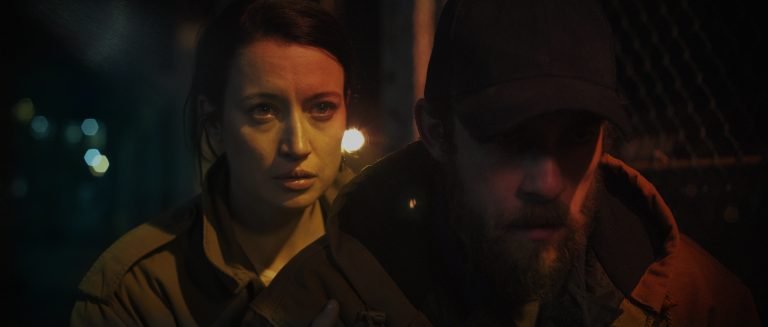“Puncture” (2011), an independent movie directed by brothers Adam and Mark Kassen —also starring the latter— dramatizes the real-life battle of Mike Weiss as he takes on America’s rigged healthcare system. At the center of the fight is a safety needle—a simple yet life-saving innovation designed to prevent needlestick injuries that had been exposing nurses to severe, often fatal diseases. But what should have been a no-brainer is met with relentless resistance, as the corporate machinery of hospitals and medical suppliers furiously works to keep it off the market.
On a filmmaking level, “Puncture” is undeniably rough around the edges. It bears the hallmarks of early-2010s indie cinema—choppy editing, uneven pacing, and an occasional lack of polish. Yet, Chris Lopata’s script is taut and uncompromising, cutting through the legal jargon with moments of striking clarity and power. The film is also anchored by a surprisingly raw turn from Chris Evans, who sheds his leading-man vanity to embody a man as charismatic as he is deeply troubled. The execution may not always land, but there’s an undeniable earnestness at its core.
“Puncture” refuses to indulge in grandiose courtroom theatrics. It treats its legal battle with a no-nonsense formalism, keeping the stakes grounded in human consequence. Yet, in its commitment to authenticity, the film risks becoming dense with institutional syntax, making it easy to get lost in the intricacies of its legal fight. If you found yourself struggling to untangle its details, we’ve got you covered. Here’s our attempt to break it down.
Puncture (2011) Movie Synopsis and Summary:
How does a routine workday turn into a life-altering crisis?
ER nurse Vicky Rogers begins her day like any other—by dropping her kids off at school before heading to her shift. But during a patient’s treatment, she suffers a needlestick injury, unknowingly contracting HIV. Three years later, she approaches Danzinger & Weiss, a struggling Houston law firm run by two vastly different attorneys: Mike Weiss, a talented but drug-addicted lawyer, and his pragmatic, straight-laced partner, Paul Danzinger.
As the firm juggles its own internal chaos—Mike’s reckless personal life includes alligator-filled house parties and a messy, gunshot-laden divorce—they take on Vicky’s case. But what begins as a wrongful injury lawsuit soon leads to something far bigger: Jeffrey Dancort, an engineer and Vicky’s family friend, has invented a safety needle designed to prevent such injuries. Yet, despite its clear benefits, hospitals refuse to adopt it.
Why is a life-saving invention being buried?
As Mike digs deeper, he uncovers a corporate stronghold on hospital supply chains. While nurses want the safety needle, hospitals and medical supply giants like United Medical Health Supplies (UMHS) are systematically rejecting it. Jeffrey reveals that he has been turned down by over 2,000 hospitals nationwide, even though 800,000 accidental needlesticks occur annually.
Tensions within the firm mount when Nathaniel Price, a corporate attorney working for UMHS, warns Mike and Paul that their small firm lacks the power and resources to fight the industry. Paul, already concerned about financial stability, starts questioning whether they should stay on the case. However, a crucial lifeline emerges—Senator O’Reilly, a staunch advocate for healthcare safety, steps in to support their fight. But just as momentum builds, tragedy strikes: Vicky Rogers succumbs to HIV-related complications.
What pushes Mike Weiss to the breaking point?

Grieving and increasingly isolated, Mike attempts to curb his addiction but instead spirals deeper, seeking comfort in sex therapy and fleeting companionship. His obsession with the case only grows when a former Thompson Needle Company employee reveals an even darker reality—after Thompson’s death, the company began distributing used needles globally, exacerbating the spread of HIV and hepatitis in Africa, Russia, and India.
A final confrontation unfolds when Nathaniel Price invites Mike, Paul, and Jeffrey to his home, offering a settlement deal that would bury the case while allowing a major corporation—likely Thompson—to buy out Jeffrey’s patent. Paul, exhausted and financially drained, considers taking the deal, but Mike refuses. Instead, he storms into Nathaniel’s house late at night, declaring that he will rally the victims and bring the fight to court.
Puncture (2011) Movie Ending Explained:
Does the case ever make it to trial?
Mike never gets the chance to fight. The next day, Paul receives a phone call—Mike has been found dead in his home from an overdose. The film doesn’t clarify whether it was an accident or something more sinister, but his death leaves Paul shattered. At the settlement conference, Nathaniel expects an easy victory. However, Paul arrives with Mark Lanier, a powerful personal injury attorney. Without hesitation, Lanier simply tells Nathaniel, “See you in court.” This marks the turning point, proving that Mike’s fight wasn’t in vain.
What impact did Mike’s efforts have in real life?
The film’s postscript reveals that in 2004, Mark Lanier settled a lawsuit against one of the largest medical supply manufacturers for over $150 million, leading to the widespread adoption of safety needles in U.S. hospitals. Paul Danzinger continues to practice law, but the film also acknowledges a sobering truth: many African nations still struggle with the use of contaminated needles, perpetuating the very crisis Mike fought to end.
Puncture (2011) Movie Themes Analyzed:
The Systemic Stranglehold on Medical Innovation
Adam and Mark Kassen frame “Puncture” within the classic David vs. Goliath struggle, where a revolutionary idea—one that could save countless lives—is systematically crushed under the weight of corporate greed. The SafetyPoint needle isn’t just an improvement; it’s an indisputable advancement over traditional syringes. Yet, rather than being embraced, it’s met with institutional silence and outright rejection. The film resists dramatizing this villainy with exaggerated flourishes. Instead, it takes a quieter, more insidious route—examining how deeply entrenched profit structures dictate what innovations see the light of day.
The obstruction follows a calculated trajectory: First, the invention is dismissed outright; when that fails, the press is weaponized to dismantle Jeffrey Dancort’s credibility. The film paints a chilling portrait of how an entire ecosystem—from hospital boards to the legal machinery—moves in synchrony to suffocate progress that threatens financial interests. Here, capitalism isn’t just a system—it’s an impenetrable fortress designed to reject change, protect profit models, and maintain the status quo.
Yet, “Puncture” never loses its measured tone. The hospitals don’t resort to dramatic threats; they simply refuse to engage. They dismiss the data, avoid conversations, and allow bureaucratic red tape to strangle reform. The real antagonist is this cold, bureaucratic indifference—a quiet but relentless machine that resists disruption. Weiss and Danzinger stand against it, battling not just legal obstacles but an entire industry’s calculated apathy.
The Cost of Advocacy

If “Puncture” is about a fight against the system, it is also about what that fight does to the people within it. At its core, the film is a character study of Michael David Weiss—a man whose brilliance is matched only by his self-destruction. His drug use and reckless behavior aren’t just personal vices; they are his way of coping. The weight of his work—the endless legal battles, the systemic resistance—manifests in his addiction, his erratic energy, and his desperate need to dull the emotional toll of his job.
This raises a crucial question: Is self-destruction purely personal, or is it an inevitable byproduct of fighting against an unyielding system? The film never explicitly answers, but it presents Mike’s unraveling as both deeply personal and painfully systemic. His relentless pursuit of justice doesn’t just exhaust him—it consumes him. His downfall isn’t due to a single moment of weakness; it is the slow, suffocating consequence of going up against something too powerful, too impenetrable.
Yet, the film doesn’t romanticize his struggle. It offers a stark contrast through Paul Danzinger—Mike’s more measured, pragmatic partner. Paul’s resistance is quieter, grounded in practical survival. He isn’t immune to doubt or exhaustion; he has a pregnant wife, financial worries, and a dwindling belief in their ability to win. But unlike Mike, he learns to navigate the chaos without letting it devour him.
What makes “Puncture” especially poignant is its refusal to frame Mike as a martyr. His death is not framed as a grand sacrifice but as a tragedy of wasted potential. The postscript tells us that Paul continued practicing law and that the legal battle did lead to change—but Mike was not there to see it. The system endures, the case becomes history, and the man who gave everything to it is reduced to a footnote.
The Ethics of Healthcare in a Capitalist Framework
For all its focus on the legal and personal battles, “Puncture” never loses sight of the larger, more insidious truth: healthcare is a business first, a public service second. The SafetyPoint needle should have been a no-brainer—a simple fix to prevent the 800,000 accidental needlestick injuries occurring every year. But the film exposes how decisions about medical advancements aren’t made based on patient safety; they are dictated by financial incentives and corporate monopolies.
The film lays bare the staggering indifference of regulatory bodies—those meant to protect healthcare workers but instead act as gatekeepers for industry profits. The courtroom becomes an emblem of legal inertia in the face of corporate lobbying, where the case’s merit is overshadowed by the sheer power of the opposition.
And yet, “Puncture” doesn’t limit its critique to the American healthcare system. It reminds us that this is a global issue. The same corporate interests that bury innovations in the U.S. allow the continued use of contaminated needles in Africa, Russia, and India. In its final moments, the film refuses to offer a neat resolution. The legal battle may have been won, but the problem persists beyond the film’s timeline. The question lingers: how many more lives will be lost before profit stops taking precedence over people?





![Loev [2017] – A Tender and Subtly Powerful Gay-Themed Cinema](https://79468c92.delivery.rocketcdn.me/wp-content/uploads/2018/01/cover2-2-768x432.jpg)


